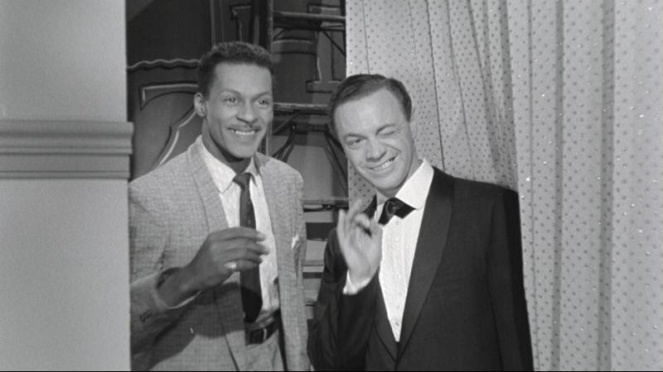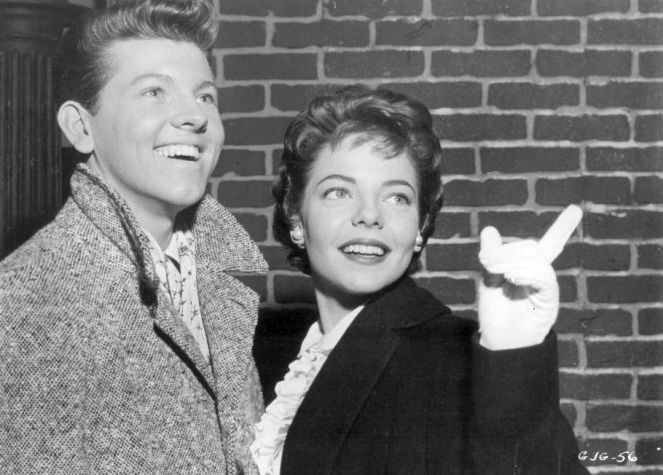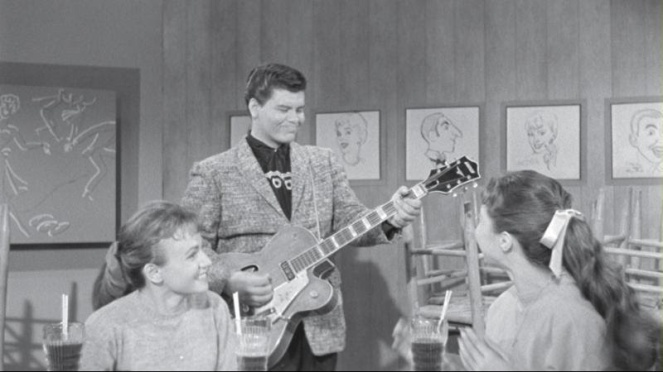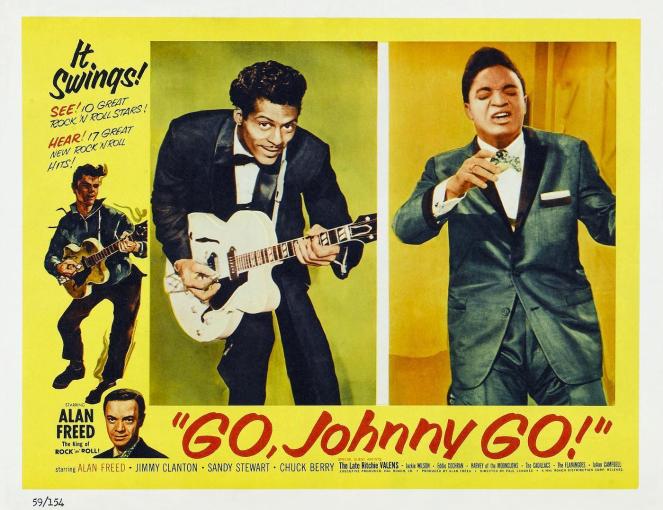
In Guide for the Film Fanatic, movie historian Danny Peary describes the 1978 biopic American Hot Wax thusly: “Floyd Mutrux’s affectionate facts-out-the-window tribute to the late Alan Freed, regarded as the first white deejay to play black music, has as flimsy a storyline as those fifties “B” rock ‘n roll movies in which Freed appeared.” Go, Johnny Go! (1959) was the last of those B-pictures to feature “Mr. Rock ‘n Roll,” just before his career came crashing down due to the early 60s “payola” scandal in the radio industry. Freed, who demonstrated admirable integrity by refusing to commit perjury by denying he had ever participated in “payola,” lost his New York broadcasting license (in addition to paying a hefty fine) and finished out his career with stations on the West Coast and Florida before his death (cirrhosis of the liver and uremia) on January 20, 1965.

Freed plays himself in Go, Johnny Go! in a story centering on a publicity stunt cooked up by his publicist (played by veteran character great Herb Vigran!) in which Freed is looking to discover a dynamic new singing talent. His discovery will be dubbed “Johnny Melody” and promoted as a rock ‘n roll sensation as only the popular rock ‘n roll deejay can. A young orphan (Jimmy Clanton) whose actual name is Johnny (we never learn his real last name, because orphan) believes he’s just the artist Freed is looking for, and during the movie’s running time employs every trick at his disposal to get to “Moondog.” When a demo cut by Johnny and played by Alan on his radio show becomes a smash, the search for “Johnny Melody” intensifies; with the help of Johnny’s girl Julie (Sandy Stewart), Freed and Melody are brought together and Johnny’s future career in the music business is solidified. (Well, for a while I’m guessing. Until he winds up having to play one of those “garden parties” that Rick Nelson memorably bitched about in song.)
 Go, Johnny Go! has been remastered and restored in High-Definition for the first time on DVD…and that disc has been released by The Sprocket Vault, the new distribution arm of Kit Parker Films which I previously mentioned in a November blog post. (The Johnny DVD is an Amazon exclusive.) It’s a nice little nostalgic wallow back to those halcyon days when, as the press release for the DVD states, “Rock & Roll changed 1950s America at 45 revolutions per minute.” It’s not great art by any stretch of the imagination: the acting is amateurish, the scripting merely standard, and the cost of the entire production was likely generated from the change for a five-dollar bill. Still, it’s impossible to dislike the movie, and there’s enough novelty in the finished product to appeal to diehard rock ‘n roll fans and classic movie buffs (there’s an overlap on the Venn diagram, natch).
Go, Johnny Go! has been remastered and restored in High-Definition for the first time on DVD…and that disc has been released by The Sprocket Vault, the new distribution arm of Kit Parker Films which I previously mentioned in a November blog post. (The Johnny DVD is an Amazon exclusive.) It’s a nice little nostalgic wallow back to those halcyon days when, as the press release for the DVD states, “Rock & Roll changed 1950s America at 45 revolutions per minute.” It’s not great art by any stretch of the imagination: the acting is amateurish, the scripting merely standard, and the cost of the entire production was likely generated from the change for a five-dollar bill. Still, it’s impossible to dislike the movie, and there’s enough novelty in the finished product to appeal to diehard rock ‘n roll fans and classic movie buffs (there’s an overlap on the Venn diagram, natch).

Chiefly of interest to your humble narrator was the presence of the legendary Chuck Berry, who as of this writing is still “reelin’ and rockin’” at the age of 90. Chuck not only performs some classic tunes (Memphis, Tennessee and Little Queenie—plus Johnny B. Goode is played over the opening credits) but he displays some impressive thespic chops despite his amateur status. Berry plays Alan’s “sidekick,” unusual for the time in that in most movies from that era Chuck would likely be assigned the role of the janitor (played by William Fawcett in this one). (Chuck comes off a lot better than Freed, who’s stiff as a board, and Jimmy Clanton, who’s white bread bland. The individuals on the DVD’s commentary track jokingly suggest that Berry is the movie’s Hoagy Carmichael, which cracked me up.) This was Chuck’s third time appearing with the man to whom he credited for his career (despite their later squabbles); Berry can also be seen in Rock Rock Rock! (1956) and Mister Rock and Roll (1957). Berry and Clanton are pretty much the only performers required to do any acting in Go, Johnny Go!—the other acts do whatever musical numbers they’ve been assigned, and then quickly exit stage left.

Still, there’s one heck of a lineup here: Ritchie Valens, in his only feature film appearance, performs Ooh My Head, and the great Eddie Cochran (in his third and final film appearance) rocks out on Teenage Heaven. (It’s a shame that we couldn’t have performances of Valens’ Donna or La Bamba—or in Cochran’s case, Summertime Blues or C’mon Everybody—but at the time movies like Go, Johnny Go! were released the songs in those films were intended to promote current singles…and not classic ones. Sucks for posterity, unfortunately.) Jackie Wilson—“Mr. Excitement” himself—is one of the movie’s highlights, with an energetic version of You’d Better Know It (Jackie’s moves were later “liberated” by James Brown, I noticed), and The Flamingos (in a far cry from their better known doo-wop ballads like I Only Have Eyes For You) demonstrate some bodacious Nicholas Brothers-like dance executions while performing the rousing Jump Children. The Cadillacs (“They often call me Speedo…”) also contribute to the fun with the Coasters-like Jay Walker and Please Mr. Johnson; rounding out the musical acts are Harvey Fuqua (formerly of The Moonglows) and Jo Ann Campbell.

Jimmy Clanton performs four songs in Go, Johnny Go! and a duet with Sandy Stewart (she also gets a pair of numbers), Once Again…and I should be honest—Clanton’s the weakest thing in the movie. (The title of the film might have inspired Clanton’s Top Ten single Go Jimmy Go, released later that year.) Jimmy would appear in one more film, Teenage Millionaire (1961) …and though I probably shouldn’t say this since I haven’t seen Millionaire, it’s a good thing Jimmy kept his day job. (If given the opportunity, I’d watch Millionaire; with a cast consisting of Rocky Graziano, ZaSu Pitts, and Maurice Gosfield—and musical numbers from Jackie Wilson, Chubby Checker, and Dion—it would be worth a flutter.) The romance between Clanton and Stewart will produce a lot of wristwatch-glancing…but fortunately, there’s always a musical number waiting in the wings to break that monotony.

Shot in five days (gosh—you’d never be able to tell!) as the last film to come out of the Hal Roach Studios in Culver City, CA (it would be released by the ill-fated Valiant Films, who were also responsible for Terror is a Man [1959] and The Flesh and the Fiends [1960]), Go, Johnny Go! was written by Gary Alexander (his only feature film credit, according to the [always reliable] IMDb) and directed by Paul Landres. Early Landres efforts like Square Dance Jubilee (1949) and Hollywood Varieties (1950) have been made available on a series of VCI “Showtime USA” releases…and on some of those same discs, film historians Richard M. Roberts, Randy Skretvedt, and Brent Walker provided audio commentary. Well, they’ve got the band back together: RMR, Randy, and Brent are also on the commentary track of Go, Johnny Go! and are the primary reason why you should be putting this disc in your Amazon shopping cart right now. (Full disclosure: Rich graciously arranged for the Johnny screener, and both Randy and Brent are Facebook chums.)

Because of their expertise—Roberts is the author of Smileage Guaranteed, Skretvedt’s latest book is a revised “ultimate” edition of his previous Laurel & Hardy: The Magic Behind the Movies, and Walker is the author of the indispensable Mack Sennett’s Fun Factory—all three men provide fascinating tidbits of trivia on both the performers and the production history of Go, Johnny Go! This might only be amusing to a character actor devotee like myself—but when an uncredited Dick Elliott turns up as the man impatiently waiting for Clanton to finish a call in a telephone booth, Brent points out that Elliott played “Mike Clancy” in several Bowery Boys films (Walker is the co-author of a favorite movie reference book of mine, The Films of the Bowery Boys). (Richard sings out: “It’s the Mayor of Mayberry!”) There are any number of familiar character faces in this feature film guaranteed to delight classic movie fans including Milton Frome, Frank Wilcox, Martha Wentworth, Phil Arnold, and Joe Flynn (uncredited as the guy who gives Clanton his walking papers at his usher job).

Movies like Go, Johnny Go! were produced at a time when disapproving bluenoses were convinced “that crazy rock ‘n roll music” was just a passing fad, and yet they were going to make a buck from the phenomenon while it was still popular. (Milton Frome’s character in the film, a choir director who kicks Johnny out because Mr. Melody is caught singing an up-tempo member, represents the “tsk-tsk” contingent…until he gets rock ‘n roll religion at the end.) Grab a copy of this DVD and enjoy a perfectly preserved time capsule of performances from some of the best artists rock ‘n roll had to offer.

3 thoughts on ““Well, I like it—I don’t dig it…but I like it.””